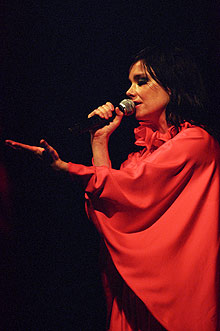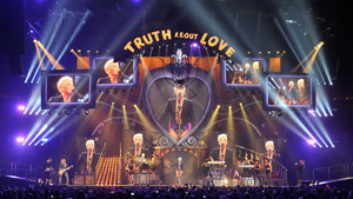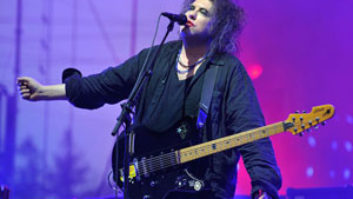
All photos: Paule Saviano
Björk’s tour in support of her new album, Volta, is a highly advanced achievement of sound and vision immersion that leaves the packed house of jaded New Yorkers at the Radio City Music Hall exhilarated by night’s end. He wasn’t onstage and most of the audience never even looked at him, but watching Björk’s front-of-house soundman, Kevin Pruce, at work is an exciting performance within the performance.
Pruce’s intensity as he works the snapshots on his Digidesign D-Show Profile console is borne out of his experience supporting Björk for nearly two decades. “I’ve worked with Björk since The Sugarcubes,” Pruce recalls. “After that long of a time, you build up a relationship. She’s not standard, and she’s never been standard, so you have to think outside the box, which is what I like about it. It’s quite a challenge.”
Björk, her highly eclectic band and crew are out on a year-plus tour of one month on, one month off, which will see Pruce, monitor engineer Bob Lopez and Jordan Zur of live sound supplier Eighth Day Sound deal with new surprises every night. The constant stream of guest stars appearing for one or two nights only at the behest of Björk’s artistic whimsy would be enough to keep any FOH/monitor tandem busy; add in her core group for the Volta tour, and things get incredibly interesting.
“Everything is about the sound for her: It’s very important that the sound is right and interpreted correctly,” explains Pruce. “It’s not a straight-ahead band. There are about 62 inputs: There is a drum kit and then there’s weird and wonderful things like a 10-piece Icelandic girl brass section that also sings and a concert pianist playing various harpsichord, celeste, organ and piano sounds, plus three gadget/techno people pushing buttons and running sequencers, and we also have a reactable [tabletop synth]. Tonight, we also have a pipa, which is a Chinese lute. Ultimately, it’s all about marrying the electronics with the natural acoustic instruments.”
At Radio City Music Hall and other premier venues where the tour will stop, the system that gets flown is a J Series line array from d&B audiotechnik. “I’ve used a lot of their systems over the years,” Pruce says. “Line arrays are pretty much the same. They each have their own little quirks and differences, but d&b boxes just seem to sound good when you turn them on. It has a passive mid-high and active low with a clever amplifier on it, and it’s the sound that I’m looking for.”
Flanking the stage in two arrays are 12 d&b J8 loudspeakers, a three-way design housing 2×12-inch LF drivers, one horn-loaded 10-inch MF driver and two 1.4-inch exit HF compression drivers with 3-inch voice-coils mounted to a dedicated wave-shaping device. Farther down on the array are a pair of d&b J12 three-way loudspeakers. “The J12s are a slightly wider-dispersion box put on the bottom as more of a downfill,” Pruce says. “We round things off with six of the J-SUB subwoofers per side. I’d been running cardioid subs before with the d&B B2, but this time they took the technology and put it in the box, which helps a lot in eliminating horrible rumbling sub-frequencies onstage.

Front-of-house engineer Kevin Pruce at the Digidesign D-Show Profile
“The d&b Q1 and Q10 passive two-way loudspeakers are fill-in boxes: The people who are seated above the orchestra pit are behind the P.A., so we put those fills in for the people in front,” he continues. “Our computer at FOH is running [SIA] Smaart and ROPE, a d&b system control, which is linked via Ethernet to the amplifiers for muting individual amps, volume changes and the like. It’s very useful for setup and troubleshooting.”
A VOICE TO BE RECKONED WITH
Experienced live, Björk’s voice is truly astounding. On recordings, her voice may come across as beautiful, fragile and hauntingly expressive; in concert, her vocals take on a strongly primal, as-old-as-Earth quality. “Björk’s voice is brilliant,” Pruce confirms. “It’s a stunning thing, and there’s nobody like her. Her microphone is a standard wireless [Shure] SM58. She’s a little bit sibilant, and over the years it’s proven to be the best mic for her. She’s got great mic technique, a lot of level. The only issue is to not make the voice too loud. She likes it to sit in the track, so it’s not voice and band but the two together. We don’t effect it too much; I add some distortion on some songs and a little reverb. Outdoors, you have to add a little more reverb or it sounds a bit strange.”
Each member of Björk’s all-female brass band sings and plays a horn, adding 20 mics to Pruce’s track count in one fell swoop. “The vocal mics there are Shure SM58s, as well,” he says. “The brass mics are clip-on Sennheiser e908Bs. They’re very good, light and don’t upset the balance of the trumpets. With the clip-on mics, at least if the players are moving, I don’t have to worry about them being off-mic.”
Miking the drums and drummer Chris Corsano is a pretty standard affair, although being ready to mix them later on during the show is anything but. Pruce applies Shure Beta 91 and Beta 52A mics to the kick and Beta 57A on the snares. An AKG 451 covers the hi-hat, while AKG 414s handle the overheads. “The drums are a bit of a challenge because a lot of his stuff is quiet and fiddly,” says Pruce. “He is not playing straight time in the normal way, but adding sounds and noises, using metal and various other toys laid on the drums. That’s a challenge to pick up in the mix. You also have to be careful so that when he comes back in and plays straight or hits a cymbal, it doesn’t rip your head off!

Monitor engineer Bob Lopez
“That’s knowing the song, and the beauty of having a digital console so that you can program it from song to song. I have a snapshot for each track with the plug-ins assigned and all the fader moves. You couldn’t do a show like this without a digital console in this day and age; it’s so complex.”
Pruce’s first run with the new Profile console earns a thumbs-up from the seasoned engineer, as the board doubles as the FOH engine and the link to Pro Tools for full archiving of each show. “We record everything, and then the following afternoon I can play back the previous show as a soundcheck tool without the band being there. It all comes back into the same channels, and if I find something that’s not right, I can restore it as a snapshot in the desk and it’s fixed.”
A MONITOR ENGINEER AND EDUCATOR
Behind the Yamaha PM5D console in the monitor position, Bob Lopez is the first to admit he’s completely jaded after too many years on the job, but that doesn’t stop him from being on full alert during soundcheck and the show. “Variety is the way to sum it up: There’s a huge amount of variety show to show,” he says. “Every time she comes out, it’s a different band. Tonight, there’s two additional artists here [Antony Hegarty and Min Xiao-Fen], and one of them has got a pipa — you can’t just slap a mic on it or it’ll get scratched. Things like that keep you on your feet.”
While the 14 d&b M2 stage monitors take good care of Björk and many of her friends onstage, with the brass section on their first tour, Lopez found he also had to play the role of educator to allow use of Shure E5 sound-isolation earphones there. “I prefer in-ears because of stage levels; it gives everyone what they want to hear at a good level without having to turn the SPL up,” he explains. “But they didn’t know what in-ear monitors were. Letting them know they could all have separate mixes each was all first-day stuff, but once we got over that, it’s been plain sailing. Björk wasn’t happy with the idea because she firmly believes that it takes away spontaneity, so we had to have quite a few discussions, try it and show her that’s not the case.”
The 17-song set’s dynamic sonic experience is paired with a thrilling laser show helmed by Paul Normandale of Lite Alternative Design. The buzz of the concertgoers filing reluctantly out of Radio City Music Hall was palpable. “I want to make Björk happy, and I want the audience to experience what she wants,” says Pruce. “She always seems to be at the front of music, pushing things along, which I always find refreshing. And she’s not doing it for commercial reasons; she’s not out to make conventional albums that will sell millions. It’s about trying to get an idea out there.”
David Weiss is Mix’s New York editor.





